Insightful newsletter of Drishtikone: Issue #240 - Wajid Ali Shah Redux
Many analysts, smart and insightful, are claiming that all threads from India's troubles lead to one billionaire - George Soros. That, when Ambani and Adani are being painted as villains. Go figure!

Image by Nick Winchetser from Pixabay
“There are some wounds that one can heal only by deepening them and making them worse.” ― Auguste de Villiers de L'Isle-Adam
A writer in the US online magazine Mother Jones exclaimed in 2013 - “Billionaires now own American Politics.”
Maybe he did not get the memo but always in history the rich and the powerful have lived off of each other. The rich and the powerful who were smart and visionary looked beyond their times and borders. They were not waiting for the future to send them more wealth or put their lives in peril, but they invested in the future that aligned with their principles, faith, and ideals.
Those rich who think they can play musical chairs with disaster and destruction of their nations and societies and yet land on a chair while others around them fall off, usually are left with neither their wealth nor a nation. It is the same with the powerful.
So what is it that makes some rich people go beyond a few coins and look at the larger picture of backing what matters? And others - to present their destiny in the hands of these proactive ones?
Want to thank Ajitji for his valuable contribution to Drishtikone! Thank you again, sir. 🙏
Understanding the Uttarakhand disaster
In 2016, Dr. Nima Namgyal Sherpa told Voice of America in an interview that glacial streams in the mid-Everest streams now start flowing in April. That was a full one month earlier than what used to happen in the past. (Source)
That was an indicator.
In a study released in June 2019 in Columbia University’s Science Advances, the researchers had shared results on the ice loss across the Himalayas over the last 40 years.
The results were shocking! The ice loss from 2000 to 2016 was a vertical foot and a half every year. Twice that of the ice loss between 1975 to 2000!
Himalayan glaciers supply meltwater to densely populated catchments in South Asia, and regional observations of glacier change over multiple decades are needed to understand climate drivers and assess resulting impacts on glacier-fed rivers. Here, we quantify changes in ice thickness during the intervals 1975–2000 and 2000–2016 across the Himalayas, using a set of digital elevation models derived from cold war–era spy satellite film and modern stereo satellite imagery. We observe consistent ice loss along the entire 2000-km transect for both intervals and find a doubling of the average loss rate during 2000–2016 [−0.43 ± 0.14 m w.e. year−1 (meters of water equivalent per year)] compared to 1975–2000 (−0.22 ± 0.13 m w.e. year−1). The similar magnitude and acceleration of ice loss across the Himalayas suggests a regionally coherent climate forcing, consistent with atmospheric warming and associated energy fluxes as the dominant drivers of glacier change. (Source)
VOA called it the “Himalayan Tsunami.”
Tsunami at Tapovan
A part of the Nanda Devi glacier broke off on Sunday near the Reni village. This has resulted in massive floods in the Tapovan area of Joshimath, Chamoli district of Uttarakhand. Around 150 laborers from the Tapovan tunnel of the Rishiganga power project are said to be missing. Houses and construction on the banks of Dhauliganga have been destroyed due to the floods. The Rishiganga power project may also have been affected.
Such floods are called glacial lake outburst floods (GLOFs). The phenomenon occurs when the boundaries of lakes at the top of glaciers are breached.
Retreating glaciers, like several in the Himalayas, usually result in the formation of lakes at their tips, called proglacial lakes, often bound only by sediments and boulders. If the boundaries of these lakes are breached, it can lead to large amounts of water rushing down to nearby streams and rivers, gathering momentum on the way by picking up sediments, rocks and other material, and resulting in flooding downstream. (Source)
It is not clear, however, if this was an avalanche or a GLOF. A team has left for the spot to ascertain that.
In a recent study done by Dr. Neha Chhabra Roy, Assistant Professor, (Financial Modeling and Risk Management) and NG Roy Consultant - Geoscience, CGI, Bangalore and published in IIMB Management Review in its September 2020 issue - titled “Risk management in small hydropower (SHP) projects of Uttarakhand: An innovative approach, “ it was suggested that RishiGanga was amongst the low-risk projects. (Source)
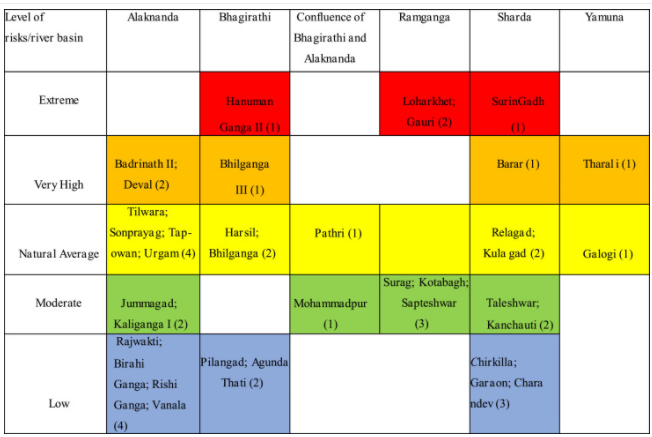
The conclusion of the paper discussed the environmental and geological risk profile, but for some reason, RishiGanga was in the low-risk profile.
The six major risk factors are environmental, geological and hydrological, technical, financial, regulatory, and socio-economic. For the study, the major sensitive risk factors were regulatory with an importance of 19.09%, geological and hydrological with 18.59%, and technical risks with 17.4%. Four projects (Hanuman Ganga, Loharkhet, Gauri and Suringad) fall under extreme risk zone, whereas five SHPs (Badrinath II, Deval, Bhilganga III, Barar and Tharali) are under very high risk zone; the remaining 27 projects fall between low to natural average risk class. It is vital to get a better understanding about significant contributing risk factors and subsequent variables which are responsible for this risk index value, with a close scanning of all projects. River basin analysis was performed across six river basins for all 36 projects. It was cross-checked as to whether all projects on a specific river basin constituted a similar risk class, but the analysis could not prove this. While geological risks are pertinent, risk is mostly governed by changing environmental/hydrological dynamics – since precipitation, river flow and soil erosion are natural phenomena – so the authors do not address this issue using mitigation measures. (Source)
In another older study, in 2016, published in Environmental Research Letters, University of Potsdam, Germany; geologist Wolfgang Schwanghart has warned of the risk.
“The dams are getting closer to glacial lakes, making them more vulnerable to GLOFs,” says Wolfgang Schwanghart, a geologist at the University of Potsdam in Germany who is lead author of the analysis published July 8 in Environmental Research Letters. (Source)
Schwanghart and his team were very categorical about the extreme risks that were presented due to Glacial flooding. Something, that the IIMB review study did not perhaps account for.
And, that may be a big miss by most evaluations done within India.
The analysis found that most hydropower projects pay little attention to GLOF risks in their hazard assessments and focused mostly on so-called meteorological floods, which are those caused by heavy rainfall. (Source)
Given the fury which was unleashed, it is clear that GLOFS may be more devastating than meteorological floods!
In yet another study from the University of Potsdam, Germany, in 2019, the researchers warned of GLOF related floods that could be more devastating.
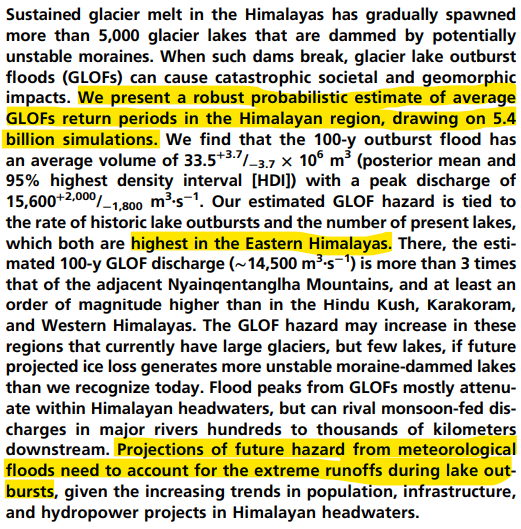
The fact is that the entire Himalayan area between the Central Himalayas and Eastern Himalayas is the most disaster-prone given the prevalence of glacial lakes.
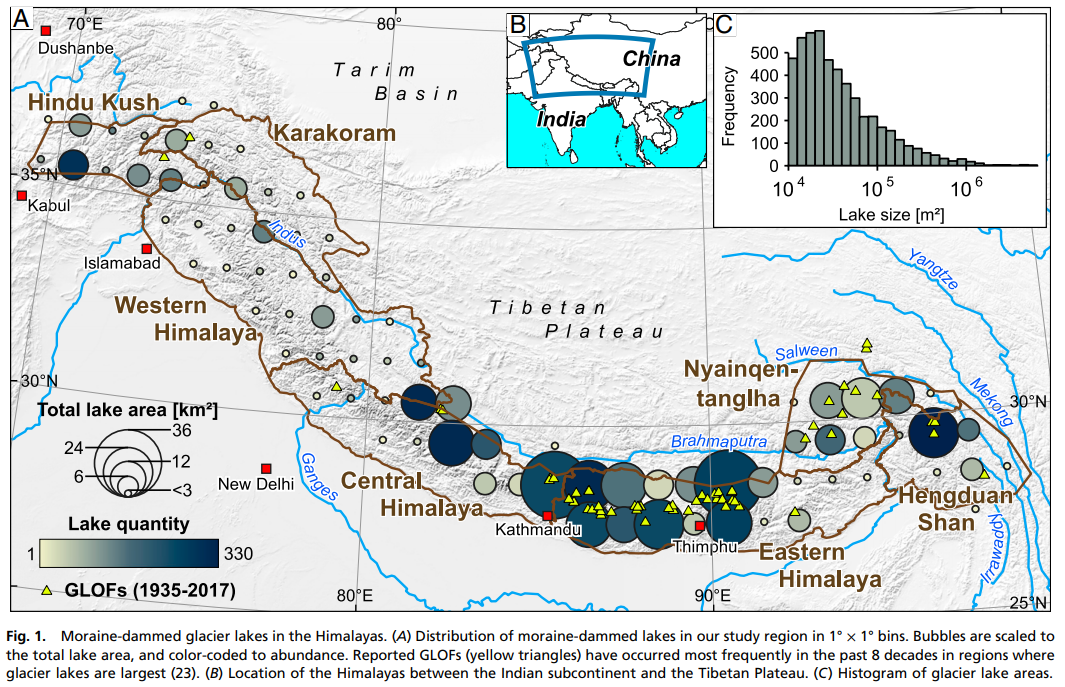
In September 2020, the International Centre of Integrated Mountain Development (ICIMOD) and the United Nations Development Programme in Nepal produced a joint report (Source). In that report, they had studied 3,624 glacial lakes were mapped in the Koshi, Gandaki and Karnali river basins of Nepal, China and India.
Of these, 1 410 lakes are large enough to cause damage downstream if they burst, while 47 need “immediate mitigation action.” 25 of these are in the Tibet Autonomous Region of China, 21 are in Nepal and one is in India. (Source)
Even though the UNDP study did not have many glacial lakes tagged in India, one thing is clear - the Himalayan region is sitting on a time bomb. From, what is now in Pakistan to all the way to China and India, lakes in the Himalayas are full to the brim with melting ice and water. They are held together by rock and sediments in a natural way. These Moraine-dammed glacier lakes in the Himalayas could trigger large-scale disasters in the coming years as a combination of climate change and development makes the glacial lakes even more vulnerable.
Now let us understand the situation in the Himalayas. Not only are millennia-old glaciers melting at an ever-increasing pace, but they are vulnerable to unleashing what would surely be like a Tsunami that happened in Uttarakhand on Sunday.
This becomes even more disastrous when there are dams being built along the rivers there which could push even greater amounts of water.
The terrain in the Uttarakhand and across the entire Himalayan region either packs indicators of disasters or showcases what we have already lost. This, for example, is the image from the Gangotri area - between Gangotri and Bhojwasa. You can see that a few years back, this landscape would have been covered by a glacier.
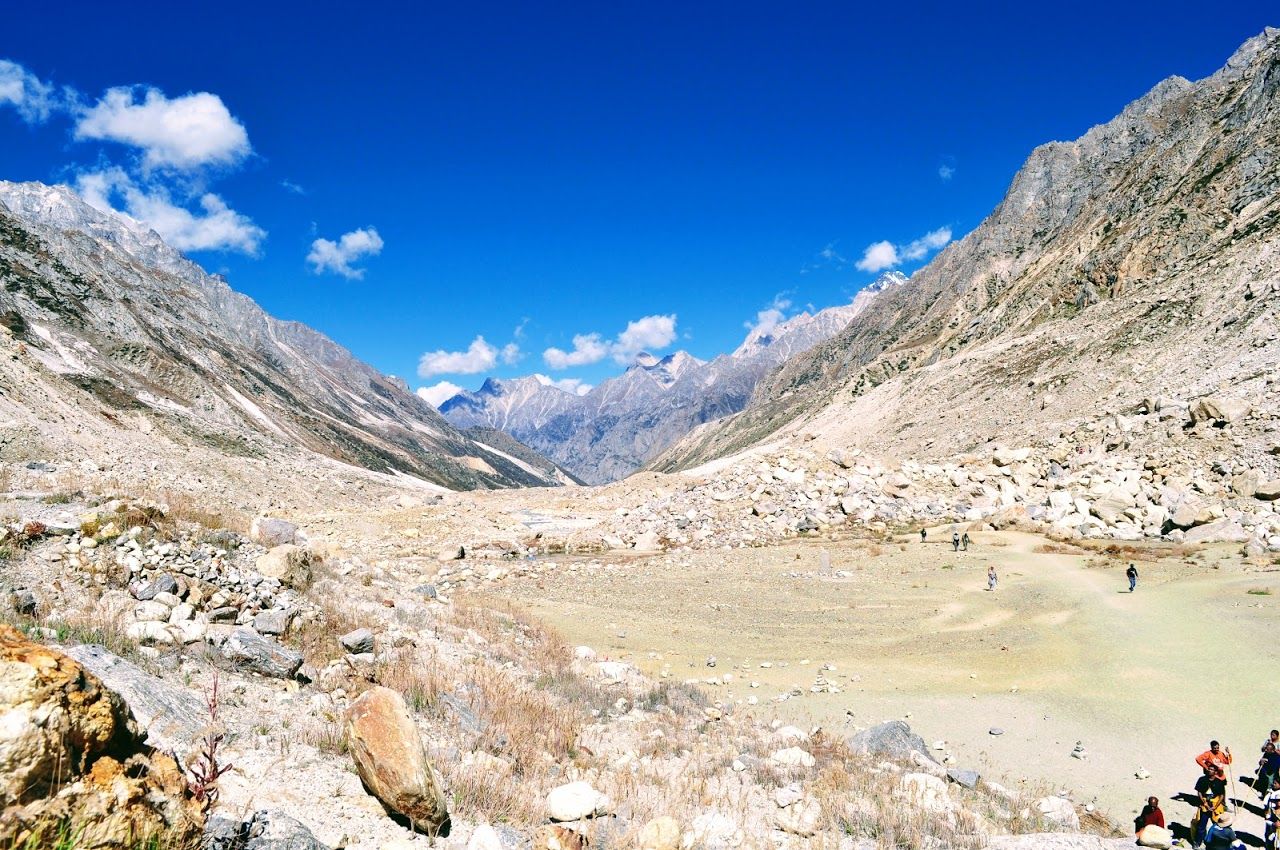
And, that is the other aspect of this situation - loss of the entire water source itself.
Soros Vs Ambani/Adani - Wajid Ali Shah redux
Super rich who are intelligent understand that money is a function of power. Those who have no power, usually cannot keep their money for long either.
An instructive lesson comes from the most powerful families of Imperial Russia. Before the riots in February 1917, Golitsyns and Sheremetevs were the richest families. The latter had 1.9 million acres of property and owned 300,000 people. After the 1917 revolution, these rich attempted to live a “normal life” of riches.
When things got worse and the communists took over, Boris Sheremetev was beaten to death while he was hiding in the local train station! That year, in the summer and autumn, thousands of estates were plundered and burned. (Source)
We had also discussed what happened when to the royal family members when the last Mughal emperor Bahadur Shah Zafar was bundled away to Rangoon (Issue #63: When power implodes - the story of Last Moghul's grand-daughter)
That is why the rich businessmen and the powerful invest in a vision of the future. It does not matter what the vision of their own country, lineage, ideals, faith, or principles is. They back those things up with their money. That is what is happening and has happened in Europe and in the US.
The former New York mayor Michael Bloomberg is known for his advocacy of gun control, gay rights, and environmental protection. George Soros (protector of human rights around the world) and Tom Steyer (focused on young people and environmental issues) have been major donors to the Democrats. In recent years, investigative journalists have also brought to public attention Charles and David Koch, mega-donors to ultra-conservative causes. (Source)
In this excellent video, String shows how the threads from Rihanna and Meena Harris, sister of the American VP, lead to George Soros. How Soros’ hand seems to be behind the Delhi Insurrection.
We saw how the Real Game is much bigger than just the Farm Bills or the poor farmers. Issue #239 - The REAL Game
If things go to the fullest extent of where indicators point to, it may impact not one but several Indian businesses apart from the Indian government and citizens.
What part of history’s lessons and future indicators do the Indian businessmen not get? Are they just simply tone deaf? Do they think that they will somehow keep quiet, bide their time and deposit their wealth in a foreign bank and survive the colonization of India?
Here are the three billionaires who are prominent in the political - nay, geopolitical - battles that are taking place in India today.
The billionaire ranked #162 is being shown to have invested smartly enough - via organizations like Human Rights Watch and Open Society Foundation (OSF) and his $1 billion fund to tackle the spread of “nationalism,” (Source) to have put the names and futures of other two billionaires ranked #155 and #21 in peril.
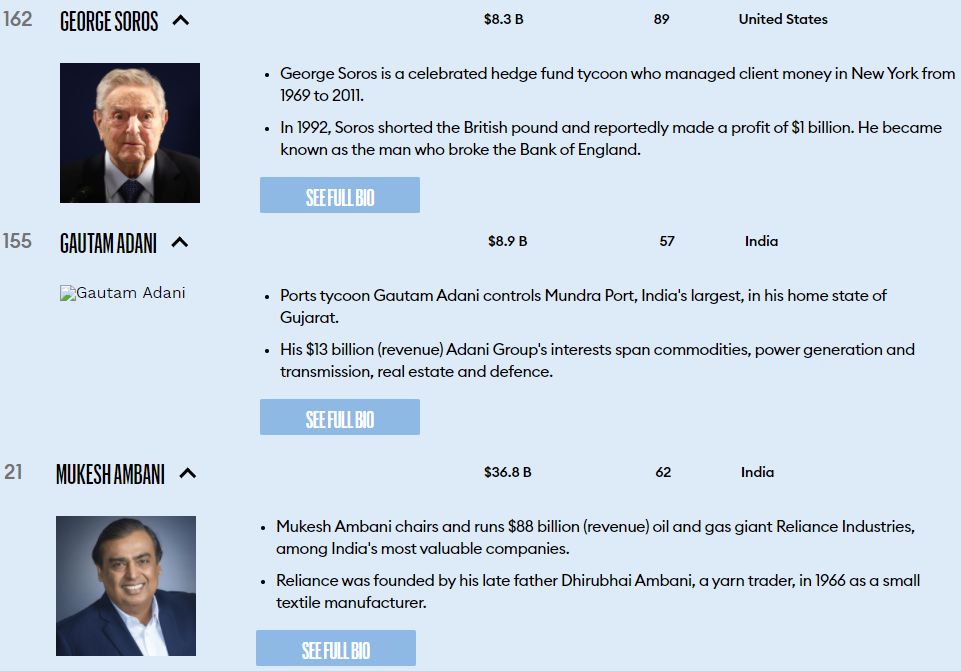
How can the American businessmen look at the world from a proactive way of geopolitical battles while their Indian counterparts, who have access to more money and power can only look at how to fiddle with Indian trinkets while the nation’s future is put in peril?
History tells us that disasters are the greatest equalizers of wealth. The rich and poor gap closes. This means - the rich lose massively.
Throughout history, only massive, violent shocks that upended the established order proved powerful enough to flatten disparities in income and wealth. They appeared in four different guises: mass-mobilization warfare, violent and transformative revolutions, state collapse, and catastrophic epidemics. Hundreds of millions perished in their wake, and by the time these crises had passed, the gap between rich and poor had shrunk. (Source)
So, if Ambani, Adani, Mahindra, Tata, etc want to do a Wajid Ali Shah while the foreign powers overthrow their entire kingdom, then how do you square that?
market corner: 10 quick bytes
- Twitter’s desi alternative Koo gets $4.1M from 3one4 Capital, Accel, Kalaari, Blume Ventures, others - more
- Bitcoin rally takes market cap of over 6,000 cryptocurrencies to a whopping new high of $1.24 trillion - more
- Govt to work with RBI for the execution of bank privatization plan: Sitharaman - more
- More than 58 lakh healthcare, frontline workers vaccinated against COVID-19 across India - more
- Confident of reducing the fiscal deficit to 4.5% of GDP by FY26 - more
- Twitter India, South Asia public policy head Mahima Kaul resigns citing personal reasons - more
- 34 aerospace, defence firms plan to invest nearly Rs 2,500 cr in Karnataka - more
- Assam gets a big connectivity boost! State’s 1st heliport, 24 flight routes, airports, water aerodromes - more
- Mumbai International Airport: Adani Airports acquires 23.5% stake for ₹1,685 crore - more
- NHAI creates a record! In a first, road construction touches 30 km per day; details here - more
nota bene
Telegram is the most-downloaded app: WhatsApp's new privacy policy has irked many of their users, and they are leaving in droves for other messaging platforms. The company is facing a massive drop in its user base while simultaneously companies like Signal and Telegram's downloads are through the roof in the last couple of months. Telegram has now become the most downloaded non-gaming app worldwide in January 2021, with 24 percent of the total downloads coming from India, followed by Indonesia at 10 percent, according to the data released by Sensor Tower. (Source)
India Foreign Minister on Toolkit: Union External Affairs Minister S Jaishankar on Saturday (February 6) said that the toolkit for farmers’ protest which was shared by Swedish climate activist Greta Thunberg on Twitter 'revealed a lot' and the international celebrities who commented on the farmers protests have spoken "on matters on which they obviously didn`t know very much".“I think it has revealed a lot. We have to wait and see what comes out,” Jaishankar said while speaking to ANI. (Source)
Largest FBI Action in History: One month after the events which left five people dead including a US Capitol police officer, there is no sign of the Department of Justice and FBI letting up in their relentless pursuit of the insurrectionists. In the past week alone there have been arrests of alleged rioters in Seattle, Washington; Las Vegas, Nevada; Corinth, Texas; Garner, North Carolina; and Marion, Illinois. All 56 FBI field offices are engaged in a huge investigation that ranks alongside the biggest the bureau has conducted. As Michael Sherwin, acting US attorney for Washington DC which is leading the hunt, has put it: “The scope and scale of this investigation are really unprecedented, not only in FBI history but probably DoJ history.”
First Flying Car: The world's first flying race car has been unveiled - with top speeds of 75mph and 'octocopter' speeders that will see it compete in a new event later this year. Named Airspeeder, it will initially be flown by a remote pilot and can take off and land vertically, according to its developers Alauda Aeronautics. Its first foray into the world of racing will see it operated remotely for a racing series that will act as a 'technical test-bed' ahead of a crewed racing series in 2022. (Source)
video corner: Section 375: Marzi Ya Zabardasti
Came across this very interesting discussion between two of the best Indie film-makers in India - Vivek Agnihotri and Manish Gupta. They discuss the context for Gupta’s movie on the threat of rape charge by women in India and its impact. Just bringing that up can put you in the cross-fire by the so-called feminists.
Because those who constantly in outrage cannot talk or understand nuances. They want to amplify everything without the slightest of sensitivity to the facts or truth. That is why it was amazing to listen in to this enriching conversation.
Today’s ONLINE PAPER: Check out today’s “The Drishtikone Daily” edition. - THE DRISHTIKONE DAILY
SUPPORT DRISHTIKONE: If you consider our work important and enriching and would like to contribute to our expenses, please click on the button below to go to the page to send in your contribution. You can select the currency (for example, INR or USD, etc) and the amount you would like to contribute. Contribute to Drishtikone
If you like this post - please share it with someone who will appreciate the information shared in this edition
If you like our newsletter, please share it with your friends and family

Comments ()